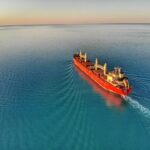Are you intrigued by the fascinating world of ship design and construction? If so, you’re in for a treat with this article. As an experienced naval architect and marine engineer, I have spent years exploring the intricate dimensions of ships and their profound impact on various aspects of vessel performance. From luxury yachts to commercial vessels, the dimensions of a ship play a crucial role in determining its stability, maneuverability, and overall efficiency. In this comprehensive analysis, we will delve deep into the subject matter, uncovering the secrets behind ship dimensions and their implications in the realm of naval engineering. So, tighten your lifejacket and get ready to set sail on this captivating journey into the world of ship dimensions.

Dimensions of Ships: Understanding the Impact on Vessel Performance
As a naval architect and marine engineer, I have spent years exploring the intricate world of ship design and construction. From luxury yachts to massive commercial vessels, I have witnessed firsthand the critical importance of ship dimensions and their impact on various aspects of vessel performance. In this article, we will delve into the fascinating realm of ship dimensions, unraveling their significance and shedding light on their role in ensuring safe and efficient maritime operations.
The Basics of Ship Dimensions
Ship dimensions, in the simplest terms, refer to the linear measurements of a ship’s structure. These include length, breadth, depth, and draught. Let’s briefly touch on each of these dimensions:
-
Length: This is the distance from the bow (front) to the stern (back) of the ship. It determines the overall size of the vessel and plays a crucial role in its maneuverability and stability.
-
Breadth: Also known as the width, breadth measures the widest part of the ship. It affects the ship’s stability and cargo-carrying capacity.
-
Depth: The vertical distance from the keel to the upper deck is referred to as the depth of a ship. It determines the volume of cargo the vessel can carry and influences its stability.
-
Draught: This dimension represents the depth of water needed to float the ship. It directly affects the vessel’s ability to navigate through different waterways and its stability, especially in shallow or restricted areas.
The Significance of Ship Dimensions
Ship dimensions play a crucial role in determining the size, shape, and stability of a vessel, which in turn impacts its overall performance. Here are some key points to consider:
-
Stability: Properly balanced ship dimensions are vital for maintaining stability at sea. By carefully designing a ship with appropriate length, breadth, depth, and draught, naval architects ensure that the vessel remains upright and able to withstand external forces such as waves and wind.
-
Cargo Capacity: Ship dimensions directly influence a vessel’s cargo-carrying capacity. By optimizing the dimensions, naval architects can maximize the available space for cargo, allowing for efficient transportation of goods.
-
Vessel Classification: Ship dimensions play a significant role in vessel classification. Ships are categorized based on their size, with categories such as Panamax and New Panamax defining the maximum dimensions that can transit the Panama Canal. These classifications help determine the operational limitations of a vessel.
-
Hydrodynamics: Ship dimensions have a profound impact on the hydrodynamics of a vessel. The shape and size of a ship affect its resistance through the water, speed, fuel efficiency, and maneuverability. By carefully considering these dimensions, naval architects can design ships that optimize performance in different operating conditions.
Moulded Dimensions and Ship Design
In ship design, accurate representations of ship size and shape are crucial. Moulded dimensions, taken during the design process, provide naval architects with precise measurements that enable them to create an accurate representation of the final vessel. These dimensions are essential for various design calculations and considerations, ensuring that the ship meets performance and safety requirements.
Safety and Stability Considerations
Safety is of utmost importance in the maritime industry, and ship dimensions play a critical role in ensuring the well-being of the vessel, crew, and cargo. Properly designed dimensions contribute to a ship’s stability, reducing the risk of capsizing or loss of control during extreme weather conditions. By adhering to international regulations governing ship dimensions, naval architects ensure that vessels are constructed safely and operate effectively in both calm and challenging waters.
Key Takeaway: Ship dimensions are not merely arbitrary numbers; they are crucial factors in ship design and construction. By carefully considering the length, breadth, depth, and draught of a vessel, naval architects can optimize performance, stability, and cargo capacity, ensuring safe and efficient maritime operations.
Further Exploration of Ship Dimensions
If you’re interested in diving deeper into the world of ship dimensions, numerous resources and websites provide valuable information. Websites like globalsecurity.org, marinersgalaxy.com, and jingsourcing.com offer additional insights into the fascinating realm of ship design and dimensions.
Now that we’ve explored the fundamentals of ship dimensions and their impact on vessel performance, it’s clear that these measurements are not to be underestimated. From stability and cargo capacity to hydrodynamics and safety, ship dimensions play a pivotal role in shaping the capabilities and efficiency of maritime vessels. As naval architects and engineers continue to push the boundaries of ship design, a comprehensive understanding of ship dimensions will remain a cornerstone of their success.
In the world of maritime engineering, one question that has intrigued sailors and enthusiasts alike is “How big is a ship?” The sheer size and scale of these floating behemoths is mind-boggling. If you’ve ever wondered about the dimensions and magnitude of these majestic vessels, you’re in for a treat. Head over to our informative article, available at this URL, where we delve into the fascinating details of ship sizes. Prepare to have your curiosity fulfilled as we explore the colossal dimensions and awe-inspiring features of these incredible marvels.
FAQ
Question 1
What are ship dimensions and why are they important in ship design and construction?
Answer 1
Ship dimensions refer to the linear measurements of a ship’s structure, including length, breadth, depth, and draught. These measurements play a crucial role in determining the size, shape, and stability of the ship. Ship designers and engineers consider these dimensions carefully to ensure the safety and performance of the vessel.
Question 2
What do the terms length, breadth, depth, and draught mean in the context of ship dimensions?
Answer 2
In the context of ship dimensions:
– Length refers to the distance from the bow to the stern of the ship.
– Breadth refers to the width of the ship.
– Depth refers to the vertical distance from the keel to the deck of the ship.
– Draught refers to the depth of water needed to float the ship.
Question 3
Are there any specific categories or classifications based on ship size?
Answer 3
Yes, ships are classified based on their size. For example, categories such as Panamax and New Panamax exist to classify ships. These classifications are important in determining the maximum dimensions a ship can have to safely navigate certain waterways or pass through particular locks.
Question 4
How do ship dimensions impact vessel performance?
Answer 4
Ship dimensions have a significant impact on various aspects of vessel performance. The size and shape of a ship, determined by its dimensions, affect its maneuverability, stability, speed, and cargo carrying capacity. Optimal ship dimensions are crucial to achieve desired performance characteristics and ensure efficient operation.
Question 5
Where can I find additional information about ship dimensions?
Answer 5
For additional information about ship dimensions, you can refer to websites such as globalsecurity.org, marinersgalaxy.com, and jingsourcing.com. These resources provide further insights into ship measurements, design considerations, and regulations governing ship dimensions.
- Unraveling Einstein’s Legacy: Who Inherited His Genius? - July 14, 2025
- Unlock Einstein’s Family Tree: Bernhard Caesar & Untold Stories - July 14, 2025
- Unveiling Bernhard Caesar Einstein: His Life & Albert Einstein’s Legacy - July 14, 2025
















